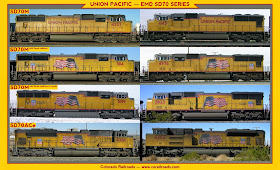 |
| For a complete guide on identifying locomotives, this is probably your best bet! Schraders / Library |
On the other hand, Identifying the model of a locomotive isn't as simple as a quick look. While it's relatively easy to tell the difference between a GE and an EMD locomotive, it's significantly more complex a task to determine the model.
This isn't a comprehensive guide. There are books like Greg McDonnell's 2008 guide that are much more researched. However, there is a fairly consistent means of identifying the two most popular, state-of-the-art models by EMD that are in use on the Union Pacific railroad (as well as BNSF). It involves examining the radiators.
 |
| Click to enlarge. Photo collage by Alan Radecki (CC 2.5), Identification and graphics by Colorado Railroads |
As late as 2004, EMD produced the previous version of the SD70s AC version, the SD70MAC, which might better explain the disparity in suffixes of the EMD model numbers.
Deciphering the EMD Model Numbers
SD stands for Special Duty because it was anticipated that this design would see only limited use as opposed to General Purpose (GP) road switchers. While GP locomotives have 4 axles, SD series have 6 axles, 3 per truck, with each axle powered independently. The notation for this by AAR standards is C-C. As far as it being Special Duty, EMD no longer produces any of the GP series.70 indicates the place in the series. As a rule, EMD numbered SD series on the 5s, but skipping 55 and 65. Since SD70, EMD filled SD75 and then SD80 and SD90 series in short succession, but the latter 2 were non-starters with design shortfalls. The SD70, like the SD40, has built a reputation for reliability.
M was applied as a suffix applied to comfort or safety cabs when they were the option and not standard. When the SD70M was introduced, the standard cab was the short hood, low nose design from the early days of EMD locomotives. Today, the situation is reversed, with any company that wants one to specify the Spartan cab. So far, the Spartan has but few takers.
AC Initially, all diesel electrics functioned using Direct Current (DC) produced by a prime mover as two phase AC and then rectified to DC. Today's AC units change that DC electricity to three-phase AC. This solves some problems that have dogged DC diesel-electrics for years.
e eco-system friendly, specifically "EPA Tier-3 emissions certified" as EMD says on their site.


No comments:
Post a Comment
Colorado Railroads is a site dedicated to preserving and presenting rail transportation in the Centennial State. Join the growing fascination with railroading and the lives and industries connected by a ribbon of steel across, over and through the Continental Divide!